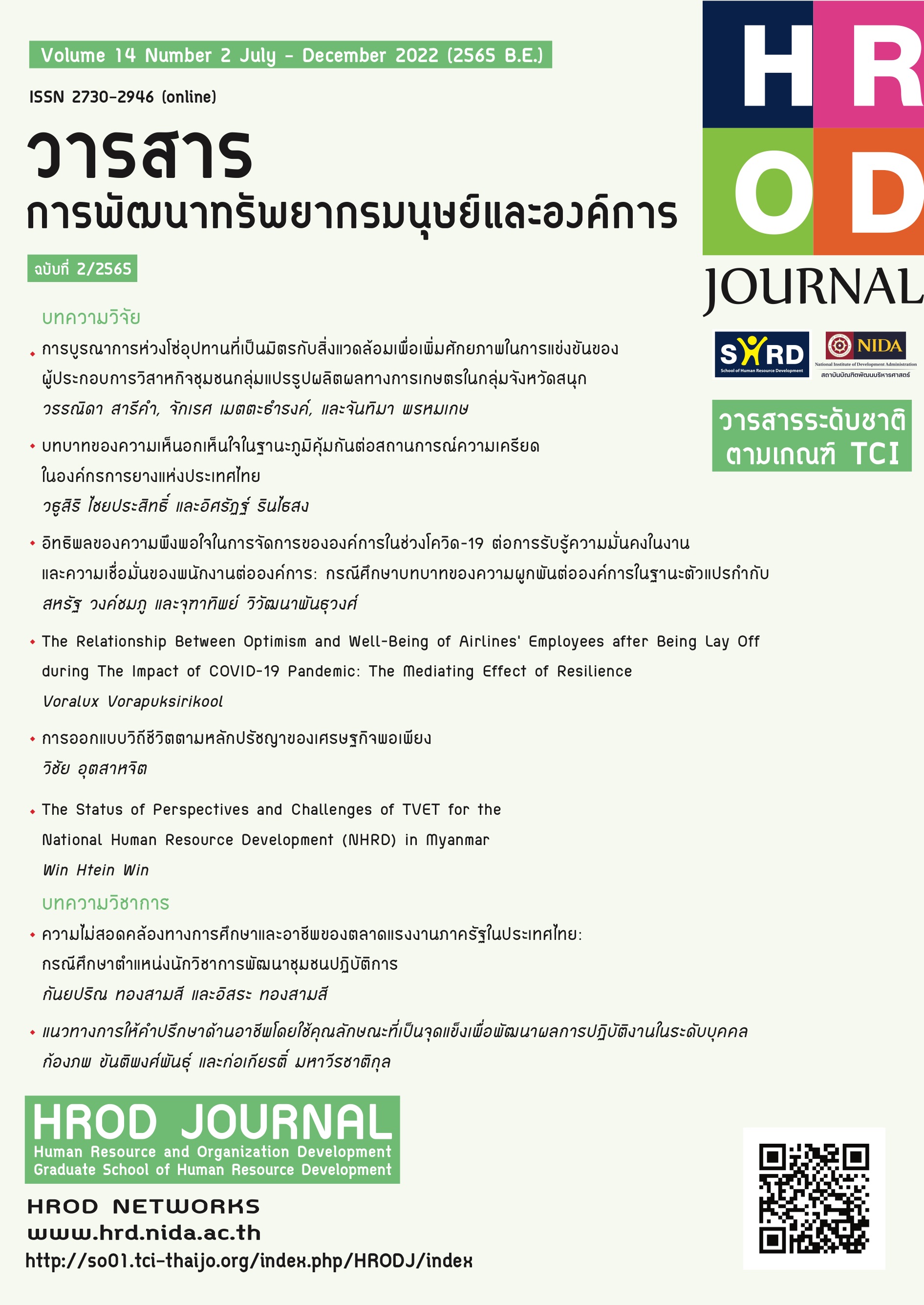Education and Public Labor Market Mismatch in Thailand: Case Study of Community Development Specialist
Main Article Content
Abstract
At the moment, 54 higher education institutions in Thailand offer 62 programs relating to community development and social development, all of which are classified as social sciences and humanities. The majority of these programs are designed to create graduates for the public, private, and self-employed sectors, whereas positions in the government sector are directed to Community Development Specialist. The purpose of this article is to provide information about education and public labor market mismatches, particularly in the field of Community Development Specialist. The data is gathered and examined using theory, empirical study, and Thai social phenomena. According to credible observations, there are 3,644 and 2,945 graduates of community development programs during the academic year 2018 - 2019. Since 2019, the Community Development Department has held competitive examinations for recruitment or placement as a Community Development Specialist at the practitioner level for those who have completed a bachelor's degree in any area. The analysis result of a dimension of a mismatch between education and career requirements in the public labor market found that a horizontal mismatch has reached 84.22 percent of hired workers. This information is useful to those in charge of the program related to community development/social development to review the program and course structure for producing graduates to public labor market. Furthermore, students can use it to help them choose their own professional route.
Article Details

This work is licensed under a Creative Commons Attribution-NonCommercial-NoDerivatives 4.0 International License.
1) The content of article in HROD journal is the author’s wholly responsibility to research, analyze, summarize, compile, and reference data. The editorial department will not be responsible in anyway.
2) The submitted articles in HROD journal must be unpublished before and must not be currently under consideration for publication elsewhere. If it is detected for its repetition, the author must be responsible for infringement of copyright.
3) Authors will be asked to transfer copyright of the article to the Publisher. The article is prohibited to reproduce all or part of the text, unless allowed.
References
กรมการพัฒนาชุมชน. (2562ก). ประกาศกรมการพัฒนาชุมชนเรื่อง รับสมัครสอบแข่งขันเพื่อบรรจุและแต่งตั้งบุคคลเข้ารับราชการในตำแหน่งนักวิชาการพัฒนาชุมชนปฏิบัติการ (พัฒนากร) ลงวันที่ 12 มิถุนายน พ.ศ. 2562.
กรมการพัฒนาชุมชน. (2562ข). ประกาศกรมการพัฒนาชุมชนเรื่อง การขึ้นบัญชีและการยกเลิกบัญชีผู้สอบแข่งขันได้ในการสอบแข่งขันเพื่อบรรจุและแต่งตั้งบุคคลเข้ารับราชการในตำแหน่งนักวิชาการพัฒนาชุมชนปฏิบัติการ (พัฒนากร) ลงวันที่ 30 กันยายน พ.ศ. 2562.
กรมการพัฒนาชุมชน. (2562ค). คำสั่งกรมการพัฒนาชุมชน ที่ 1070/2562 เรื่องบรรจุและแต่งตั้งผู้สอบแข่งขันได้ ลงวันที่ 14 พฤศจิกายน พ.ศ. 2562.
กรมการพัฒนาชุมชน. (2562ง). หนังสือที่ มท 0406.6/5777 โครงการพัฒนาข้าราชการที่อยู่ระหว่างทดลองปฏิบัติหน้าที่ราชการ หลักสูตรพัฒนากรก่อนประจำการรุ่นที่ 111.
เจสสิกา เวชบรรยงรัตน์ และศศิวิมล วรุณศิริ ปวีณวัฒน์. (2560). สถานการณ์ความไม่สอดคล้องกันของระดับการศึกษาและอาชีพในตลาดแรงงานไทย. ฐานเศรษฐกิจ, 37(3,318). สืบค้น 1 พฤษภาคม 2564, จาก https://www.thansettakij.com/columnist/236049
พิริยะ ผลพิรุฬห์ เดือนฉาย กองเงิน และกชชญาณ์ เถาลัดดา. (2559). ความไม่สอดคล้องทางการศึกษาและผลกระทบต่อตลาดแรงงานไทย. พัฒนาการเศรษฐกิจปริทรรศน์, 10(2), 118-150.
ศูนย์สารสนเทศอุดมศึกษา สำนักงานคณะกรรมการการอุดมศึกษา. (2564ก). ดาวน์โหลดสถิติอุดมศึกษา: นักศึกษารวม. สืบค้น 31 พฤษภาคม 2564, จาก http://www.info.mua. go.th/info/table_stat_02.php?id_member=
ศูนย์สารสนเทศอุดมศึกษา สำนักงานคณะกรรมการการอุดมศึกษา. (2564ข). ดาวน์โหลดสถิติอุดมศึกษา: ผู้สำเร็จการศึกษา. สืบค้น 31 พฤษภาคม 2564, จาก http://www.info.mua.go.th/info/table_stat_03.php?id_member=
สำนักงานคณะกรรมการข้าราชการพลเรือน. (2552). วิชาการพัฒนาชุมชน ฉบับแก้ไขเพิ่มเติมครั้งที่ 1. สืบค้น 31 พฤษภาคม 2564, จาก https://www.ocsc.go.th/job/วิชาการพัฒนาชุมชน
สำนักงานคณะกรรมการข้าราชการพลเรือน. (2564). การรับรองคุณวุฒิในประเทศ. สืบค้น 24 พฤษภาคม 2564, จาก http://e-accreditation.ocsc.go.th/acc/index.html
สำนักงานปลัดกระทรวงการอุดมศึกษา วิทยาศาสตร์ วิจัยและนวัตกรรม. (2562). ข้อมูลสถิติอุดมศึกษา ปีการศึกษา 2561. กรุงเทพฯ: บริษัท ซีโน พับลิชชิ่ง แอนด์ แพคเกจจิ้ง จำกัด.
สำนักงานสถิติแห่งชาติ กระทรวงดิจิทัลเพื่อเศรษฐกิจและสังคม. (2564). อัตราการเรียนต่อระดับมัธยมศึกษาและอุดมศึกษา ปีการศึกษา 2553 - 2562. สืบค้น 19 เมษายน 2564, จาก http://statbbi.nso.go.th/staticreport/page/sector/th/03.aspx
สำนักงานสถิติแห่งชาติ กระทรวงดิจิทัลเพื่อเศรษฐกิจและสังคม. (2564). สรุปผลการสำรวจภาวการณ์ทำงานของประชากร (เดือนธันวาคม พ.ศ.2563). สืบค้น 1 เมษายน 2564, จาก http://www.nso.go.th/sites/2014/DocLib13/ด้านสังคม/สาขาแรงงาน/ภาวะการทำงานของประชากร/2563/Report_12_63.pdf
สำรวจพบคนอายุน้อยทำงานไม่ตรงสายกว่าร้อยละ 60. (2561, 4 พฤษภาคม). มติชนออนไลน์. สืบค้น 12 เมษายน 2562, จาก https://www.matichon.co.th/economy/news_941499
อิสระ ทองสามสี และกันยปริณ ทองสามสี. (2559, 26-29 พฤษภาคม). ความไม่สอดคล้องของการศึกษาต่อตลาดแรงงาน ในตำแหน่งนักวิชาการพัฒนาชุมชนระดับปฏิบัติการ (พัฒนากร). ใน การประชุมวิชาการระดับชาติมหาวิทยาลัยทักษิณ ครั้งที่ 26 ปี 2559 บูรณาการงานวิจัยเพื่อสังคม (น. 601-606). โรงแรมบุรีศรีภูบูติก, หาดใหญ่, สงขลา.
อิสระ ทองสามสี และกันยปริณ ทองสามสี. (2562, 12-13 กรกฎาคม). ความไม่สอดคล้องกันของระดับการศึกษาและอาชีพในตลาดแรงงาน: กรณีศึกษาผู้สอบแข่งขันได้ในตำแหน่งนักวิชาการพัฒนาชุมชนปฏิบัติการ พ.ศ.2560-2562. ใน การประชุมหาดใหญ่วิชาการระดับชาติและนานาชาติ ครั้งที่ 10 (น. 895-905). มหาวิทยาลัยหาดใหญ่.
Caroleo, F. E., & Pastore, F. (2018). Overeducation at a glance. Determinants and wage effects of the educational mismatch based on Almalaurea data. Social Indicators Research, 137(3), 999-1032.
de Rugy, V., & Salmon, J. (2019). Higher education and the school-work mismatch in an evolving labor market [Mercatus Research Paper]. http://dx.doi.org/10.2139/ssrn.3515345
Dolton, P.J., & Vignoles, A. (2000). The incidence and effects of overeducation in the UK graduate labour market. Economics of Education Review, 19(2), 179-198.
Dunlavy, A. C., Garcy, A. M., & Rostila, M. (2016). Educational mismatch and health status among foreign-born workers in Sweden. Social Science & Medicine, 154, 36-44.
Kohnová, L., Papula, J., Papulová, Z., Stachová, K., & Stacho, Z. (2020). Job mismatch: The phenomenon of overskilled employees as a result of poor managerial competences. Entrepreneurship and Sustainability Issues, 8(1), 83-102. http://doi.org/10.9770/jesi.2020.8.1(6)
Korpi, T., & Tåhlin, M. (2009). Educational mismatch, wages, and wage growth: Overeducation in Sweden, 1974–2000. Labour Economics, 16(2), 183-193.
Montt, G. (2017). Field-of-study mismatch and overqualification: Labour market correlates and their wage penalty. IZA J. Labor Economics, 6(2), 1-20. https://doi.org/10.1186/s40172-016-0052-x
Mauteau, S., Mavromaras, K., Sloane, P., & Wei, Z. (2015). Horizontal and vertical educational mismatch and wages. Flinders University.
Pala, A. H., Bichanga, W., & Atambo, W. (2015). Effects of educational mismatch on employee performance: A case study of Co-operative Bank of Kenya Ltd. Global Business and Economics Research Journal, 4(5), 1-15.
Quang, H. L., & Tran-Nam, B. (2019). Qualification mismatch in the labor market and the impact on earnings: Evidence from Vietnam. Journal of Economics and Development, 21(2), 223-233. https://doi.org/10.1108/JED-09-2019-0032
Rasovec, T., & Vavrinova, T. (2014). Mismatch in the Czech Republic: Comparison of different approaches applied on PiAAC data. Statstika, 94(3), 58-79.
Sam, V. (2020). Impacts of educational mismatches on job satisfaction: The case of university graduates in Cambodia International. Journal of Manpower, 41(1), 84-99. https://doi.org/10.1108/IJM-07-2018-0229
Sellami, S., Verhaes, D., & Van Trier, W. (2018). How to measure field‐of‐study mismatch? A comparative analysis of the different methods. Labour, 32(4), 141-173.
Ziberi, B. (2020). Skills mismatch in the labor market a precondition of brain-drain phenomenon in developing countries with special emphasis in Kosovo. Bilimler Dergisi Near Eastern Journal of Social Sciences, 6, 24-30.


